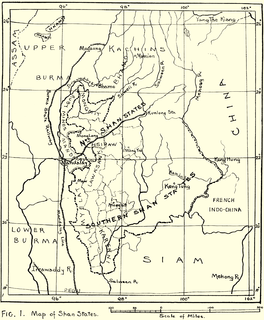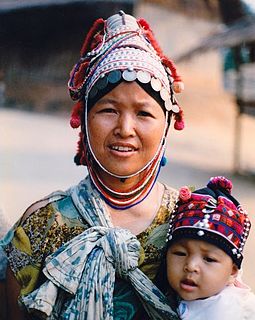Related Research Articles

The Wa people are a Southeast Asian ethnic group that lives mainly in Northern Myanmar, in the northern part of Shan State and the eastern part of Kachin State, near and along Myanmar's border with China, as well as in China's Yunnan Province.
The Lisu people are a Tibeto-Burman ethnic group who inhabit mountainous regions of Myanmar (Burma), southwest China, Thailand, and the Indian state of Arunachal Pradesh.

The Lahu people are an ethnic group of China and Mainland Southeast Asia.

Jewish Christians were the followers of a Jewish religious sect that emerged in Judea during the late Second Temple period. The Nazarene Jews integrated the belief of Jesus as the prophesied Messiah and his teachings into the Jewish faith, including the observance of the Jewish law. The name may derive from the city of Nazareth, or from prophecies in Isaiah and elsewhere where the verb occurs as a descriptive plural noun, or from both. Jewish Christianity is the foundation of Early Christianity, which later developed into Christianity. Christianity started with Jewish eschatological expectations, and it developed into the worship of a deified Jesus after his earthly ministry, his crucifixion, and the post-crucifixion experiences of his followers. Modern scholarship is engaged in an ongoing debate as to the proper designation for Jesus' first followers. Many see the term Jewish Christians as anachronistic given that there is no consensus on the date of the birth of Christianity. Some modern scholars have suggested the designations "Jewish believers in Jesus" or "Jewish followers of Jesus" as better reflecting the original context.
James Outram Fraser was a British Protestant Christian missionary to China with the China Inland Mission. He pioneered work among the Lisu people, of Southwestern China, in the early part of the 20th century. He is credited with the Fraser script for their language.

Christianity in China has been present since at least the 7th century and has gained a significant amount of influence during the last 200 years. The Syro-Persian Church of the East appeared in the 7th century, during the Tang dynasty. Catholicism was among the religions patronized by the Mongol emperors in the Yuan dynasty, but did not take root until it was reintroduced in the 16th century by Jesuit missionaries. Starting in the early nineteenth century, Protestant missionaries attracted small but influential followings, and independent Chinese churches followed.

Lisu Church is a Christian church of an ethnic minority of southern China, Myanmar, Thailand and a part of India. The Chinese government's State Administration for Religious Affairs has proposed considering Christianity the official religion of the Lisu.

The Shan States (1885–1948) were a collection of minor Shan kingdoms called muang whose rulers bore the title saopha in British Burma. They were analogous to the princely states of British India.

The Golden Triangle is the area where the borders of Thailand, Laos, and Myanmar meet at the confluence of the Ruak and Mekong rivers. The name "Golden Triangle"—coined by the CIA—is commonly used more broadly to refer to an area of approximately 950,000 square kilometres (367,000 sq mi) that overlaps the mountains of the three adjacent countries.
Panthays form a group of Chinese Muslims in Burma. Some people refer to Panthays as the oldest group of Chinese Muslims in Burma. However, because of intermixing and cultural diffusion the Panthays are not as distinct a group as they once were.

Christianity in Myanmar has a history dating to the early 18th century. According to the 2016 census, Christianity is the country's second largest religion, practiced by 6.3% of the population, primarily among the Kachin, Chin and Kayin, and Eurasians because of missionary work in their respective areas. About four-fifths of the country's Christians are Protestants, in particular Baptists of the Myanmar Baptist Convention; Roman Catholics make up the remainder.

Protestants in Thailand constitute about 0.77% of the population of Thailand. Protestant work among the Thai people was begun by Ann Judson in Burma, who evangelized Thai war captives who were relocated to Burma. Protestantism was introduced to the country of Thailand in 1828 through the work of Karl Gutzlaff and Jacob Tomlin, the first two resident Protestant missionaries in Thailand.

Christianity was first introduced to Thailand by European missionaries. It represents 1.17% of the national population, which is predominantly Buddhist. Christians are numerically and organizationally concentrated more heavily in the north, where they make up an estimated 16% of some lowland districts and up to very high percents in tribal districts.

The village of Santikhiri, formerly known as Mae Salong, is in the Thai highlands on Doi Mae Salong mountain of the Daen Lao Range, in Mae Fa Luang District, Chiang Rai Province, the northernmost province of Thailand. The area has an alpine-like landscape and climate, and is known for its hill tribe villages, tea plantations, and cherry blossoms.

Christians are people who follow or adhere to Christianity, a monotheistic Abrahamic religion based on the life and teachings of Jesus Christ. The words Christ and Christian derive from the Koine Greek title Christós (Χριστός), a translation of the Biblical Hebrew term mashiach (מָשִׁיחַ).
Protestants are the 4th largest religious group in Serbia, after Eastern Orthodox Christians, Roman Catholics and Muslims. In the 2011 census, there were 71,284 Protestants in Serbia and they comprised 1% of the population of the country. Ethnic Slovaks constitute majority of Serbia's Protestant community. Some members of other ethnic groups are also adherents of various forms of Protestant Christianity.
The Bible has been translated into many of the languages of China besides Chinese. These include major minority languages with their own literary history, including Korean, Mongolian, Tibetan, Kazakh, Kyrgyz, Russian and Uyghur. The other languages of China are mainly tribal languages, mainly spoken in Yunnan in Southwest China.
Laomian is a Sino-Tibetan language and is a Chinese derivation of the Lahu name Lawmeh. Laomian is closely related to the Bisu language, is spoken in Laomian Dazhai 老缅大寨, Zhutang Township 竹塘乡, Lancang County, Yunnan. There are 4,000 speakers in central Lancang County, Yunnan, and fewer than 1,000 Laopin speakers, which may not be included in these numbers. Its language family consists of Sino-Tibetan, Tibeto-Burman, Ngwi-Burmese, Ngwi, Southern, Bisoid, Bisu-Pyen-Laomian, Bisu, Pyen, and Laomian. It is mostly spoken in China in the Southwestern areas of Yunnan Province that joins Thailand and Myanmar. Speakers of Laomian that live in areas with different ethnic groups mostly speak Laomian in their home, while using the main local ethnic language in public. The average age of Laomian speakers is increasing into the sixties to seventies in areas of heterogeneous communities because children are learning the main local language. The domination of Chinese language has had a major impact on the villages of the Laomian people due to the increasing number of people who can speak multiple languages.

The recorded arrival of Christianity to the Akha people in Thailand is in the 19th century.

The Kuomintang in Burma were Chinese Nationalist troops that fled from Communist-controlled Red China to Burma in 1950 after their defeat by the Communists in the Chinese Civil War. Officially the Yunnan Anti-communist National Salvation Army, the Chinese Nationalist troops in Burma were commanded by General Li Mi. It attempted several incursions into Yunnan in the early 1950s, only to be pushed back into Burma each time by the Chinese Communist Party's People's Liberation Army.
References
- 1 2 3 "Lahu tribal Nazarenes celebrate a decade of holiness and growth". Global Weekly Summary, Nazarene Communications Network News. 2004. Archived from the original on 2006-02-16. Retrieved 2006-06-02.
- 1 2 Chan Kim-kwong (2001). "Gospel and Opium: A Case Study in China" (PDF). Gospel and Opium: A Case Study in China. Retrieved 2006-06-02.[ permanent dead link ]
- 1 2 3 4 "Lahu (China)". OMF International. 2001. Retrieved 2006-06-02.[ dead link ]
- 1 2 Buker, Robert H. (2001). "Wasted Years?". Christian Reader. Archived from the original on 2006-05-27. Retrieved 2006-06-02.
- ↑ "Adherents.com". Adherents.com. Archived from the original on December 6, 2003. Retrieved 2006-06-02.CS1 maint: unfit URL (link)